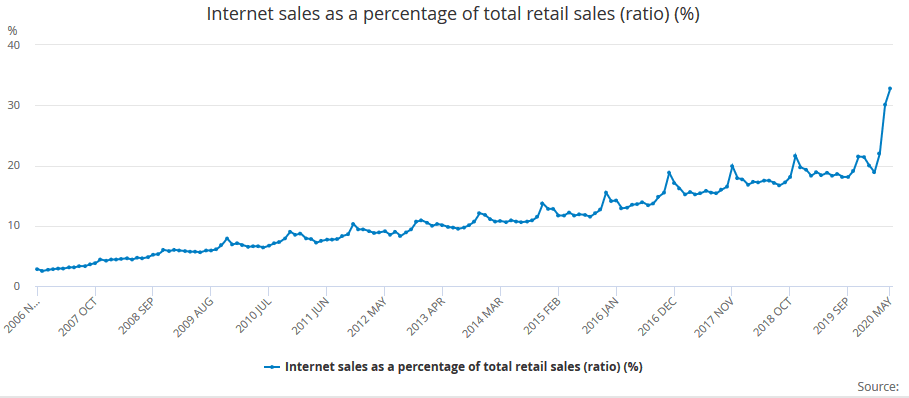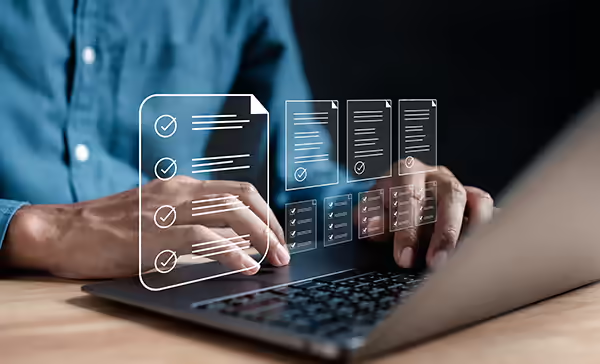No-one saw it coming, but the world has changed since only March 2020.
Society at-large has significantly changed, as has the daily lives of virtually everyone around the globe. And as consumers, of course, this changes how we act and shop. And so companies needed to adapt.
So what has the pandemic and subsequent lockdown done to consumer and business behaviour, and what should our digital marketing and ecommerce strategies encompass in order to strive for success post-lockdown?
We have taken a look at some of the big statistics to come out of the lockdown period to shed light on where businesses need to focus time, energy and money regarding ecommerce and digital marketing.
Digital marketing and ecommerce during lockdown
Ecommerce rose to 33.4% of all retail sales in the UK in May 2020. This is an unprecedented level of ecommerce sales as people could not go out to the shops. While people are now allowed to return to physical stores, ecommerce is surely set to remain at a higher percentage than pre-lockdown levels.

Retail sales increased 12% compared with the fall in April. This was still down 13% on February before the lockdown commenced. People are much more comfortable entering stores now, even with the social distancing measures in place.
Footfall jumped 38.8% due to non-essential shops reopening on the 15th of June over all retail destinations. The high street saw 50.5% footfall on June 15th compared to the week before.
59% of UK consumers shopped in more local stores since lockdown to support local business. Therefore local businesses now have an opportunity to thrive in the face of big business as consumer mentality shifts.
57% of consumers surveyed said they were more likely to buy from a brand that sells locally sourced products after lockdown than they would have before COVID.
1 in 5 said they stopped buying from a brand due to their response to COVID – whether that’s due to safety concerns or otherwise. For instance, despite Wetherspoons being one of the most popular pubs in the UK, many people will boycott it upon opening due to its response to staff when lockdown occurred.
61% of social media users under 35 used social media apps to look up news updates during April 2020, which is a 9% increase in social content consumption compared to January. In the 35-55 age bracket it rose 8% to 42% and 35% of over 55s which is a rise of 6%. This will continue as more people use these platforms to check the news.
The rise of TikTok has continued, which saw children aged 4 to 15 in the UK watch 83 minutes of TikTok content per day, compared to 81 minutes of YouTube a day. This has meant that social app usage among this age group has growth by 200% this year, after a rise of 100% in 2019.
TikTok has gone from 5.4 million users to 12.9 million UK users from January and April 2020. With people at home in lockdown, more people had time to create and consume the video content on the platform, which also aligned with the big marketing push from the social network, on TV, online and otherwise.
Houseparty grew from 175,000 users to 4 million users in the same period. Zoom saw growth from 659,000 users in January to 13 million in April – a growth of 2000%. All in all, most video chat platforms have grown but Houseparty and Zoom were the biggest names in this segment.
What do post-lockdown digital marketing and ecommerce strategies entail?
If you could be selling online and have yet to make the jump, then opening your own ecommerce store will be critical.
With the shift in consumer behaviour and more businesses making use of online platforms to sell, it means it’s become more widely used with more people becoming familiar and comfortable shopping online. Even though lockdown is easing, some of these behaviours will continue and be reluctant to head out unnecessarily.
Saying this, there’s also increased competition online with more businesses coming to realise that they need to be online. This is why planning ahead with a solid digital marketing strategy is cvritical to succeed.
In terms of content marketing, you cannot act as though everything is normal. Your content should reflect the mood of the nation, as should your social media activity.
Ensuring your website stays up-to-date with the easing levels of lockdown is also important. One example is hairdressers and barbers – many websites have allowed for bookings to be scheduled during the lockdown. So now that people are looking for post-4th of July dates, how can you take their booking system or opening dates seriously? If they had blocked out the calendar or made it clear they were reopen for bookings from the date they are legally about to be, it would ensure more legit bookings and more confidence from those with the lockdown mullets.
Your customers don’t know if things are back to normal or not within your business. Ensure you provide this information at all touchpoints – whether on your website, social media, email or otherwise.
You need to be prepared for extra customers when business resumes. The general public is mostly ready to get back to normal life, and are keen to shop as normal. Make sure you are prepared and ready for this while keeping in mind any social distancing measures or online requirements necessary. If you have a store, ensure your offline safety measures are communicated online so your customers are also well prepared.
If you need help in developing a digital marketing strategy for a post-lockdown world or in general, get in touch with the team at Xanthos who will be more than happy to discuss how to take your business forwards.
Alternatively, we are offering a free digital marketing or ecommerce consultation to help businesses out during this time.












